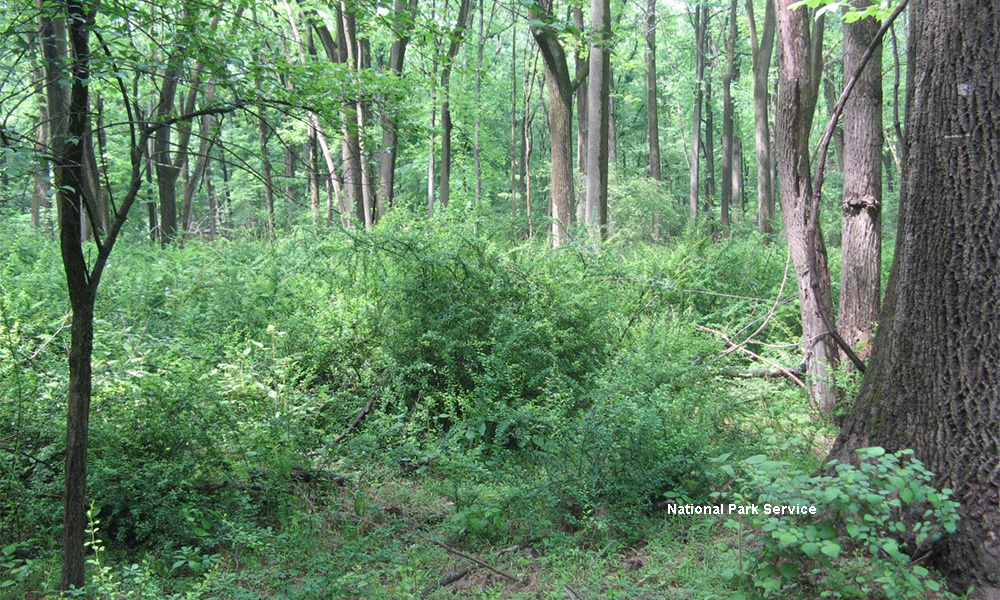Invasive Plants Threaten National Parks; Vermont Manages to Decrease Invasive Population
Feb. 23rd 2021Invasive plant species, or plants that are not naturally found in an ecosystem, are becoming established in eastern U.S. National Parks. Invasive plants cause harm to forest ecosystems, including loss of ecosystem services and economic costs. Once introduced to an area, they are able to spread easily and displace native plants. The novel appearance of invasive plants in National Parks is creating an urgent need for long-term resources to manage their introduction and spread. National Parks often consist of forests with older stands and greater diversity than the land surrounding them. However, invasive plants are increasing in abundance and threaten the long-term condition of these parks.
Researchers from the National Park Service conducted a 12-year study of 1,479 plots at 39 national park units from Virginia to Maine, including Marsh-Billings-Rockefeller National Historical Park in Woodstock, Vermont. In fact, Marsh-Billings-Rockefeller was also one of only two of the 39 parks in the study that experienced an overall decline in invasive plant abundance over time, likely the result of the park’s persistent and extensive invasive management efforts.
The primary objective of the research project was to identify invasive plant species that consistently achieve and maintain high abundance and/or exhibit rapid expansion across the region. Plants were defined as invasive if they were non-native and their introduction was likely to cause native ecosystem impacts. Plant species were identified on plots on a four-year rotating basis, thus most plots were sampled three times. Trends of invasive population frequency and cover in plots and one-meter quadrats within plots were used to evaluate rates of establishment and expansion.
Overall, invasive plants in National Parks have generally increased since the study began. Parks with the greatest impact from invasive species were located near densely populated areas such as Washington, D.C. and Boston, Massachusetts. Invasive species that were most commonly found were Japanese stiltgrass (Microstegium vimineum), multiflora rose (Rosa multiflora), and Japanese honeysuckle (Lonicera japonica).
To address the threat of invasive plants, the authors recommend natural resource management be included in the overall infrastructure maintenance that is being planned for many parks to provide long-term resources for invasive plant control. Other state and federal lands can be managed using similar methods to what Vermont has accomplished with Marsh-Billings-Rockefeller to help minimize the impact of invasive plants to ecosystems.
What drives the increase in invasive plants is not fully understood, but the researchers discuss several possibilities, including white-tailed deer browsing, climate change, fragmentation and urbanization, invasive plant management, and latitude. This study does not examine these drivers, but the authors recommend future studies to better evaluate these possibilities and how to best manage under different conditions.
This research provides valuable information about the spread of invasive plants in National Parks, but the lessons learned can be used on other eastern lands, including state-owned forests and parks. Japanese stiltgrass and multiflora rose were the most common invasive species found among parks in the study, although Japanese stiltgrass has not yet been found in Vermont or New Hampshire parks. More locally, exotic bush honeysuckle (Lonicera spp.), European buckthorn (Rhamnus cathartica), and Japanese barberry (Berberis thunbergii) were the most common invasive species found at the Vermont Marsh-Billings-Rockefeller National Historical Park.
For further information, please watch a recording of author Kate Miller, Plant Ecologist at the National Park Service, discuss the research findings at the annual FEMC conference here.
 ecoNEWS VT
ecoNEWS VT